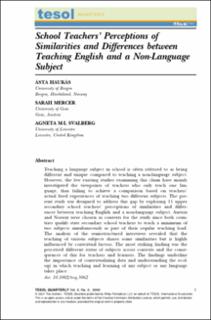| dc.contributor.author | Haukås, Åsta | |
| dc.contributor.author | Mercer, Sarah | |
| dc.contributor.author | Svalberg, Agneta | |
| dc.date.accessioned | 2021-09-10T12:15:36Z | |
| dc.date.available | 2021-09-10T12:15:36Z | |
| dc.date.created | 2021-08-11T18:24:16Z | |
| dc.date.issued | 2021 | |
| dc.identifier.issn | 0039-8322 | |
| dc.identifier.uri | https://hdl.handle.net/11250/2775239 | |
| dc.description.abstract | Teaching a language subject in school is often referred to as being different and unique compared to teaching a non-language subject. However, the few existing studies examining this claim have mainly investigated the viewpoints of teachers who only teach one language, thus failing to achieve a comparison based on teachers’ actual lived experiences of teaching two different subjects. The present study was designed to address this gap by exploring 11 upper secondary school teachers’ perceptions of similarities and differences between teaching English and a non-language subject. Austria and Norway were chosen as contexts for the study since both countries qualify state secondary school teachers to teach a minimum of two subjects simultaneously as part of their regular teaching load. The analysis of the semi-structured interviews revealed that the teaching of various subjects shares some similarities but is highly influenced by contextual factors. The most striking finding was the perceived different status of subjects across contexts and the consequences of this for teachers and learners. The findings underline the importance of contextualizing data and understanding the ecology in which teaching and learning of any subject or any language takes place. | en_US |
| dc.language.iso | eng | en_US |
| dc.publisher | Wiley Periodicals LLC on behalf of TESOL | en_US |
| dc.rights | Navngivelse 4.0 Internasjonal | * |
| dc.rights.uri | http://creativecommons.org/licenses/by/4.0/deed.no | * |
| dc.title | School Teachers’ Perceptions of Similarities and Differences between Teaching English and a Non-Language Subject | en_US |
| dc.type | Journal article | en_US |
| dc.description.version | publishedVersion | en_US |
| dc.rights.holder | Copyright 2021 The Authors. | en_US |
| cristin.ispublished | true | |
| cristin.fulltext | original | |
| cristin.qualitycode | 2 | |
| dc.identifier.doi | https://doi.org/10.1002/tesq.3062 | |
| dc.identifier.cristin | 1925424 | |
| dc.source.journal | TESOL Quarterly | en_US |
| dc.identifier.citation | TESOL Quarterly. 2021. | en_US |

